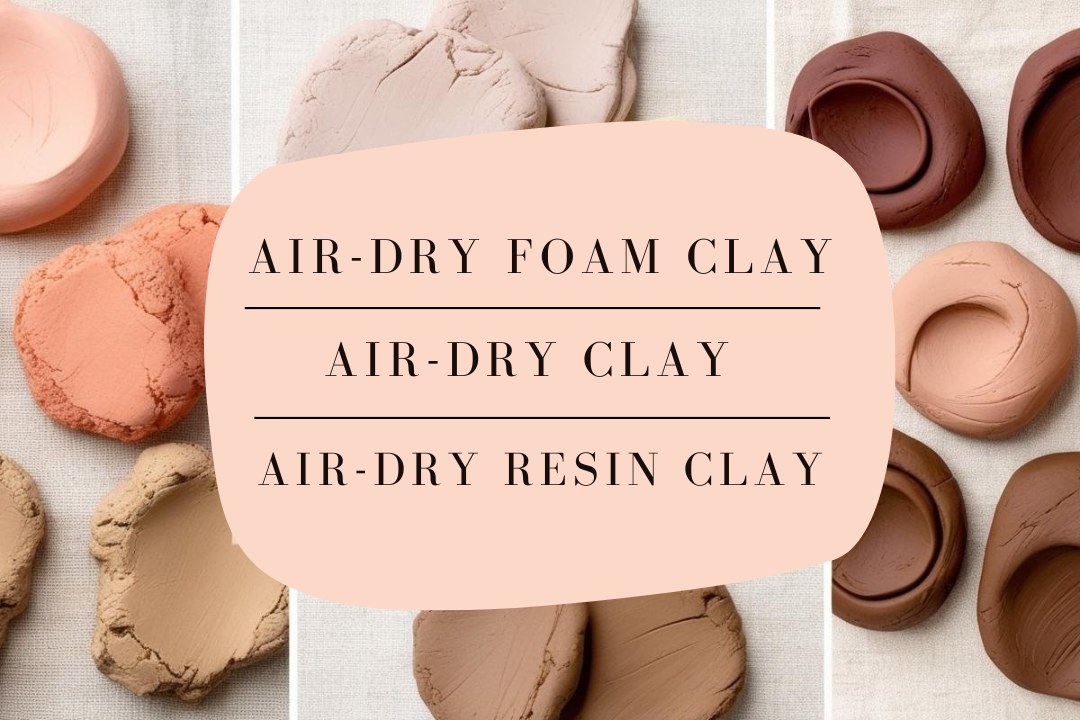
Welcome to the confusing world of modeling clay: Air-Dry Foam Clay, Air-Dry Resin Clay and Air-Dry Clay in Comparison
Share
If you delve into the world of air-drying modeling clay, you'll quickly realize: not all clay is created equal. Depending on whether you want to create kawaii charms, realistic flowers, or sculptures, choosing the right material is crucial. The situation doesn't become any clearer when you leave the Western understanding of polymer clay (e.g. Fimo or Sculpey) and delve into the Japanese world of air-dry clay. Quite the opposite; it's easy to lose sight of the forest for the trees and not immediately familiar with the various categories. Today we want to turn our attention to exclusively air-drying modeling clays that are not (and shouldn't be!) hardened in the oven.
In this post, we compare three popular types: Air Dry Foam Clay (like Mermaid Puffy ), Air-Dry Resin Clay (e.g., Modena ), and air-dry clay (e.g., DAS, Jovi ).
We explain the drying process, processing, properties and best applications – including advantages and disadvantages.
🌬️ Air-Dry Foam Clay (also known as "Soft Clay")
✅ What is this?
Air-Dry Foam Clay is super light, soft, and almost marshmallow-like. Ideal for kawaii crafts, fake sweets, or kid-friendly projects.
🔄 Drying:
- Dries in the air (usually within 24 hours)
- Hardens from the outside to the inside
- Often remains slightly flexible after drying
🎨 Processing & Properties:
- Very soft and easy to shape
- Can be pulled, pressed and rolled flat like clay
- Suitable for thin layers or small portions
- Adheres well to various surfaces (paper, plastic, etc.)
🌟 Best suited for:
- Kawaii and fantasy charms
- Lightweight key rings or bag charms
- Crafting with children
- Fake sweets (e.g. cream, cookies, icing)
👍 Advantages:
- Extremely light
- Soft and safe for children
- Can be colored as desired before or after drying/ often comes in premixed colors or in white (professional product)
- Crack-free when drying
👎 Disadvantages:
- Not suitable for fine details
- Quickly becomes sticky or too soft when wet
- Not dimensionally stable for larger objects
💎 Air-Dry Resin Clay
✅ What is this?
Air-Dry Resin Clay is a high-quality, high-performance modeling clay. Despite its name, it doesn't contain any actual resin—the term refers to its smooth, durable surface after drying. In fact, the clay is partially composed of polymers, which is why the Japanese often refer to it as "polymer clay." This, as expected, is confusing for Westerners, as we immediately associate polymer clay with oven-hardening modeling clay.
🔄 Drying:
- Dries completely in 1–3 days (depending on thickness)
- Becomes water-repellent and slightly flexible
- Can be sanded, drilled or painted after drying
🎨 Processing & Properties:
- Smooth, elastic and tear-resistant
- Excellent for fine details and delicate petals
- Often slightly transparent when dry – ideal for realistic effects
- Can be colored with acrylic or oil paints
🌟 Best suited for:
- Realistic flowers & plants
- Miniature sweets with fine details
- Jewelry making with filigree elements
- Artistic sculptures
👍 Advantages:
- Robust, durable and flexible after curing
- Detailed processing possible
- Semi-transparent, realistic surface
- Crack-resistant
👎 Disadvantages:
- More expensive than other keys
- May be a bit sticky or difficult to mix for beginners
- Not ideal for large or heavy molds
🏺 Air-drying clay
✅ What is this?
The classic among modeling clays – usually white, gray, or terracotta in color. It is heavier, slightly fibrous, and highly versatile. Most contain cellulose fibers and kaolin or calcium carbonate, which are responsible for their clay-like texture.
🔄 Drying:
- Dries in the air in 1–3 days
- Becomes hard, but can crack if dried unevenly
- Porous and brittle without sealing
🎨 Processing & Properties:
- Suitable for larger shapes and textured surfaces
- Can be shaped similarly to pottery clay
- Can be painted, carved or sealed after drying
- Often sold in larger blocks
🌟 Best suited for:
- Sculptures or figures
- Decorative items such as bowls, coasters or wall art
- DIY pottery-style projects
- School and beginner work
👍 Advantages:
- Affordable and widely available
- Ideal for larger or heavy projects
- Good stability and weight
👎 Disadvantages:
- Tends to crack when drying
- Heavier and not flexible
- Only limited suitable for fine details
- Must be sealed if moisture is involved
| Characteristic | Air Dry Foam Clay | Resin Clay | Air-drying clay |
|---|---|---|---|
| texture | Soft, fluffy, elastic | Smooth, elastic | Firm, slightly fibrous |
| Weight | Ultralight | Light | Difficult |
| Attention to detail | Small amount | High | Medium |
| durability | Medium (flexible) | High (flexible) | Medium (brittle) |
| Suitable for | Kawaii crafts, children | Flowers, miniatures | Sculptures, decoration |
| Drying time | 12–24 hours | 24–72 hours | 24–72 hours |
| surface | Matte, soft | Smooth, water-repellent | Hard, porous |
| Risk of cracking | Small amount | Small amount | High |
🎯 Conclusion: Which modeling clay is right for your project?
- For beginners, children, or when a soft end result is desired: Air-Dry Foam Clay is safe, lightweight, and easy to handle.
- For delicate, professional work and when a smooth cured finish is desired: Air-Dry Resin Clay is ideal – especially for realistic designs.
- For large, robust objects: Air-drying clay provides stability and structure.
Each modeling clay has its strengths—and sometimes they can even be combined! For example, Foam Clay as an accent on a resin base.